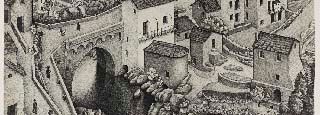M.C. Escher Revisted
Yesterday Jane brought you her Magnificent Mansions post on the remarkable and inspiring Alhambra - the palace and fortress complex on al-Sabika hill, on the banks of the River Darro located in Granada, Andalusia, in the south of Spain.
And as Jane recounted yesterday, this is where Jane and I met and our wonderful friendship started and evolved into being part of the team that produces the AnArt4Life blog.
Jane's post brought into focus the works created by Maurits Cornelis Escher (1898–1972) the a Dutch graphic artist who made mathematically inspired woodcuts, lithographs, and mezzotints.1
His work features mathematical objects and operations including impossible objects, explorations of infinity, reflection, symmetry, perspective, truncated and stellated polyhedra, hyperbolic geometry, and tessellations. Although Escher believed he had no mathematical ability, he interacted with the mathematicians George Pólya, Roger Penrose, Harold Coxeter and crystallographer Friedrich Haag, and conducted his own research into tessellation.1
Early in his career, he drew inspiration from nature, making studies of insects, landscapes, and plants such as lichens, all of which he used as details in his artworks. He traveled in Italy and Spain, sketching buildings, townscapes, architecture and the tilings of the Alhambra and the Mezquita of Cordoba, and became steadily more interested in their mathematical structure.1
Escher's art became well known among scientists and mathematicians, and in popular culture, especially after it was featured by Martin Gardner in his April 1966 Mathematical Games column in Scientific American. Apart from being used in a variety of technical papers, his work has appeared on the covers of many books and albums. He was one of the major inspirations of Douglas Hofstadter's Pulitzer Prize-winning 1979 book Gödel, Escher, Bach.1
The AnArt4Life blog has featured Escher in several posts so please over the next couple of days follow these Bookmark links to enjoy some of our thoughts on this great artist.



Credit
1. en.wikipedia.org

